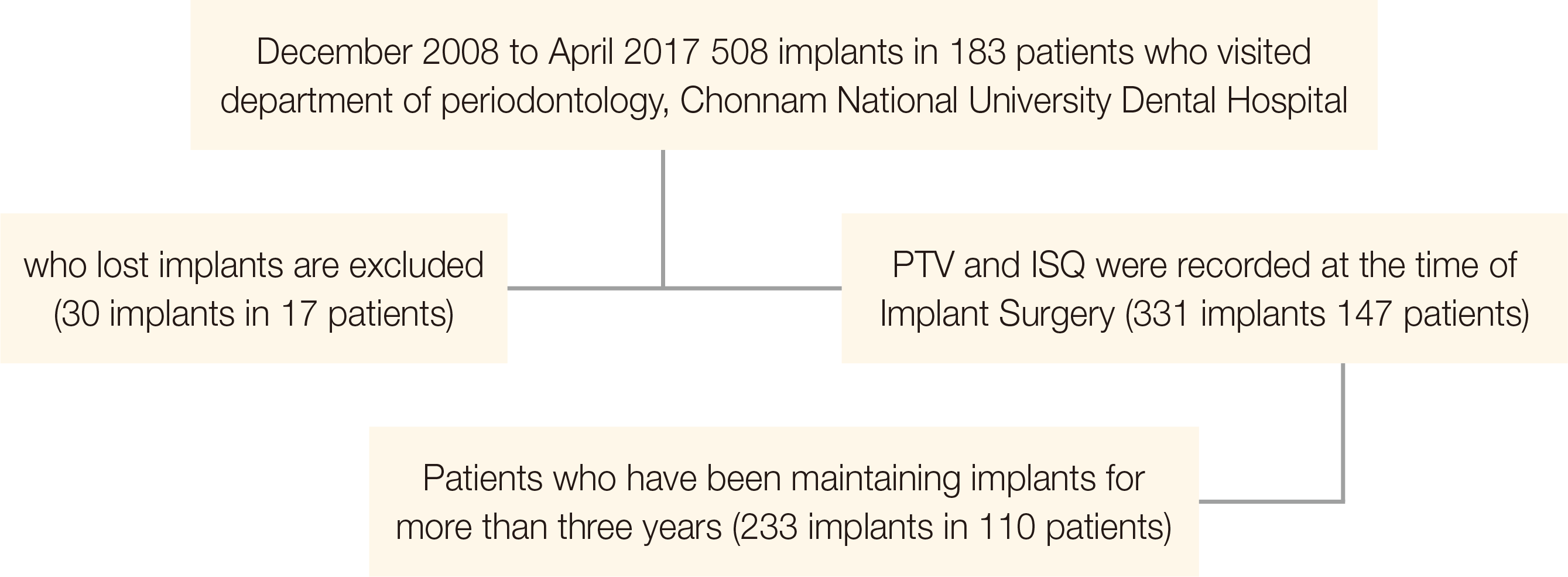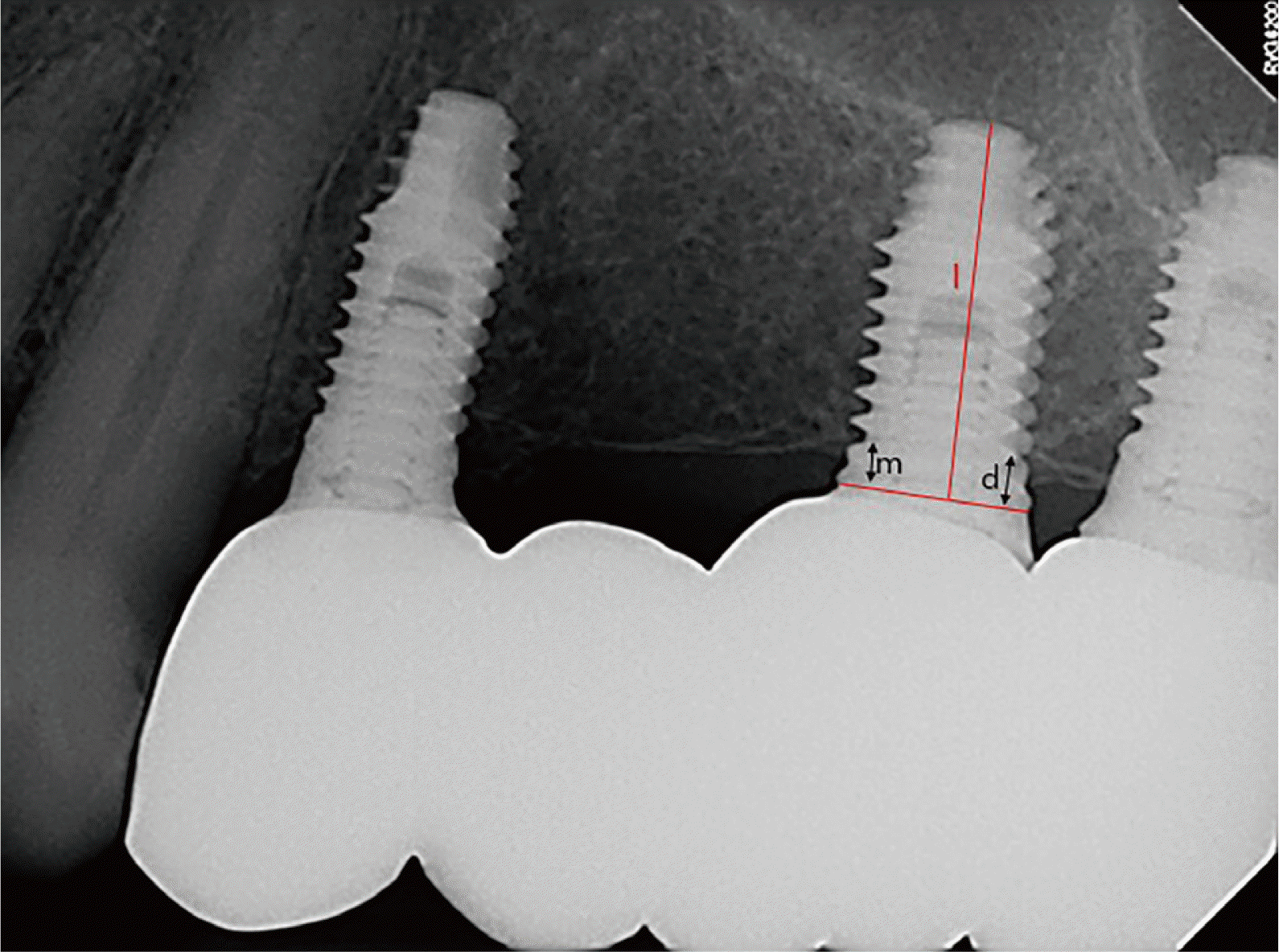1. Brånemark PI, Svensson B, van Steenberghe D. 1995; Ten-year survival rates of fixed prostheses on four or six implants ad modum Brånemark in full edentulism. Clin Oral Implants Res. 6:227–31. DOI:
10.1034/j.1600-0501.1995.060405.x. PMID:
8603114.

2. Mengel R, Schröder T, Flores-de-Jacoby L. 2001; Osseointegrated implants in patients treated for generalized chronic periodontitis and generalized aggressive periodontitis: 3- and 5-year results of a prospective long-term study. J Periodontol. 72:977–89. DOI:
10.1902/jop.2001.72.8.977. PMID:
11525449.

3. Buser D, Ingimarsson S, Dula K, Lussi A, Hirt HP, Belser UC. 2002; Long-term stability of osseointegrated implants in augmented bone: a 5-year prospective study in partially edentulous patients. Int J Periodontics Restorative Dent. 22:109–17. PMID:
12019706.
4. Brägger U, Hirt-Steiner S, Schnell N, Schmidlin K, Salvi GE, Pjetursson B, Matuliene G, Zwahlen M, Lang NP. 2011; Complication and failure rates of fixed dental prostheses in patients treated for periodontal disease. Clin Oral Implants Res. 22:70–7. DOI:
10.1111/j.1600-0501.2010.02095.x. PMID:
21158932.

5. Jung RE, Zembic A, Pjetursson BE, Zwahlen M, Thoma DS. 2012; Systematic review of the survival rate and the incidence of biological, technical, and aesthetic complications of single crowns on implants reported in longitudinal studies with a mean follow-up of 5 years. Clin Oral Implants Res. 23:2–21. DOI:
10.1111/j.1600-0501.2012.02547.x. PMID:
23062124.
6. Lang NP, Zitzmann NU. 2012; Clinical research in implant dentistry: evaluation of implant-supported restorations, aesthetic and patient-reported outcomes. J Clin Periodontol. 39:133–8. DOI:
10.1111/j.1600-051X.2011.01842.x. PMID:
22533953.

7. Pjetursson BE, Thoma D, Jung R, Zwahlen M, Zembic A. 2012; A systematic review of the survival and complication rates of implant-supported fixed dental prostheses (FDPs) after a mean observation period of at least 5 years. Clin Oral Implants Res. 23 Suppl 6:22–38. DOI:
10.1111/j.1600-0501.2012.02546.x. PMID:
23062125.
8. Chiapasco M. 2004; Early and immediate restoration and loading of implants in completely edentulous patients. Int J Oral Maillofac Implants. 19:76–91. PMID:
15635948.
9. Cochran DL, Nevins M. 2012; Biologic width: a physiologically and politically resilient structure. Int J Periodontics Restorative Dent. 32:371–3. PMID:
22577641.
10. Moy PK, Medina D, Shetty V, Aghaloo TL. 2005; Dental implant failure rates and associated risk factors. Int J Oral Maxillofac Implants. 20:569–77. PMID:
16161741.
11. Ahmed A, Chambers MS, Goldschmidt MC, Habib A, Lei X, Jacob RF. 2012; Association between microbial flora and tissue abnormality around dental implants penetrating the skin in reconstructed oral cancer patients. Int J Oral Maillofac Implants. 27:684–94. PMID:
22616064.
13. Adell R, Lekholm U, Rockler B, Brånemark PI. 1981; A 15-year study of osseointegrated implants in the treatment of the edentulous jaw. Int J Oral Surg. 10:387–416. DOI:
10.1016/S0300-9785(81)80077-4. PMID:
6809663.

14. Sennerby L, Merdith N. 2008; Implant stability measurements using resonance frequency analysis: biological and biomechanical aspects and clinical implications. Periodontol 2000. 47:51–66. DOI:
10.1111/j.1600-0757.2008.00267.x. PMID:
18412573.

15. Rosenberg ES, Cho SC, Elian N, Jalbout ZN, Froum S, Evian CI. 2004; A comparison of characteristics of Implant failure and survival in periodontally compromised and periodontally healthy patients: a clinical report. Int J Oral Maillofac Implants. 19:873–9. PMID:
15623064.
16. Misch CE, Perel ML, Wang HL, Sammartino G, Galindo-Moreno P, Trisi P, Steigmann M, Rebaudi A, Palti A, Pikos MA, Schwartz-Arad D, Choukroun J, Gutierrez-Perez JL, Marenzi G, Valavanis DK. 2008; Implant Success, Survival, and Failure: the International Congress of Oral Implantologists (ICOI) Pisa Consensus Conference. Implant Dent. 17:5–15. DOI:
10.1097/ID.0b013e3181676059. PMID:
18332753.

17. Peñarrocha M, Palomar M, Sanchis JM, Guarinos J, Balaguer J. 2004; Radiologic study of marginal bone loss around 108 dental implants and its relationship to smoking, implant location, and morphology. Int J Oral Maxillofac Implants. 19:861–7. PMID:
15623062.
18. de Medeiros RA, Pellizzer EP, Vechiato Filho AJ, Dos Santos DM, da Silva EV, Goiato MC. 2016; Evaluation of marginal bone loss of dental implants with internal or external connections and its association with other variables: A systematic review. J Prosthet Dent. 116:501–6. DOI:
10.1016/j.prosdent.2016.03.027. PMID:
27422232.

19. Lemos CAA, Verri FR, Bonfante EA, Santiago Júnior JF, Pellizzer EP. 2018; Comparison of external and internal implant-abutment connections for implant supported prosthesis. A systematic review and meta-analysis. J Dent. 70:14–22. DOI:
10.1016/j.jdent.2017.12.001. PMID:
29221955.

20. Caricasulo R, Malchiodi L, Ghensi P, Fantozzi G, Cucchi A. 2018; The influence of implant-abutment connection to peri-implant bone loss: A systematic review and meta-analysis. Clin Implant Dent Relat Res. 20:653–64. DOI:
10.1111/cid.12620. PMID:
29761902.

21. Knowles JW, Burgett FG, Nissle RR, Shick RA, Morrison EC, Ramfjord SP. 1979; Results of periodontal treatment related to pocket depth and attachment level. Eight years. J Periodontol. 50:225–33. DOI:
10.1902/jop.1979.50.5.225. PMID:
287778.

22. Ramfjord SP, Caffesse RG, Morrison EC, Hill RW, Kerry GJ, Appleberry EA, Nissle RR, Stults DL. 1987; Four modalities of periodontal treatment compared over 5 years. J Periodontal Res. 22:222–3. DOI:
10.1111/j.1600-0765.1987.tb01573.x. PMID:
2955103.

23. Ramfjord SP, Morrison EC, Burgett FG, Nissle RR, Shick RA, Zann GJ, Knowles JW. 1982; Oral hygiene and maintenance of periodontal support. J Periodontol. 53:26–30. DOI:
10.1902/jop.1982.53.1.26. PMID:
6948947.

25. Choi SJ, Jeong HN, Kim OS. 2018; Effect of supportive periodontal therapy on long-term implant survival rate. Oral Biol Res. 42:228–34. DOI:
10.21851/obr.42.04.201812.228.

26. Balshi SF, Wolfinger GJ, Balshi TJ. 2007; An examination of immediately loaded dental implant stability in the diabetic patient using resonance frequency analysis (RFA). Quintessence Int. 38:271–9. PMID:
17432781.
27. Fiorellini JP, Chen PK, Nevins M, Nevins ML. 2000; A retrospective study of dental implants in diabetic patients. Int J Periodontics Restorative Dent. 20:366–73. PMID:
11203576.
28. Kapur KK, Garrett NR, Hamada MO, Roumanas ED, Freymiller E, Han T, Diener RM, Levin S, Ida R. 1998; A randomized clinical trial comparing the efficacy of mandibular implant-supported overdentures and conventional dentures in diabetic patients. Part I: Methodology and clinical outcomes. J Prosthet Dent. 79:555–69. DOI:
10.1016/S0022-3913(98)70177-5. PMID:
9597609.

30. Dao TT, Anderson JD, Zarb GA. 1993; Is osteoporosis a risk factor for osseointegration of dental implants? Int J Oral Maxillofac Implants. 8:137–44. DOI:
10.1097/00008505-199404000-00014. PMID:
8359868.
31. Blomqvist JE, Alberius P, Isaksson S, Linde A, Hansson BG. 1996; Factors in implant integration failure after bone grafting: an osteometric and endocrinologic matched analysis. Int J Oral Maxillofac Surg. 25:63–8. DOI:
10.1016/S0901-5027(96)80015-4. PMID:
8833304.
32. Truhlar RS, Morris HF, Ochi S, Winkler S. 1994; Assessment of implant mobility at second-stage surgery with the Periotest: DICRG Interim Report No. 3. Dental Implant Clinical Research Group. Implant Dent. 3:153–6. DOI:
10.1097/00008505-199409000-00002. PMID:
7749399.
33. Friberg B, Sennerby L, Meredith N, Lekholm U. 1999; A comparison between cutting torque and resonance frequency measurements of maxillary impalnts. A 20-month clinical study. Int J Oral Maxillofac Surg. 28:297–303. DOI:
10.1016/S0901-5027(99)80163-5.

34. Vidyasagar L, Salms G, Apse P, Teibe U. 2004; Dental implant stability at stage I and II surgery as measured using resonance frequency analysis. Stomatologija. 6:67–72.




 PDF
PDF Citation
Citation Print
Print




 XML Download
XML Download